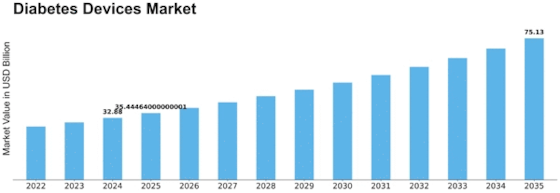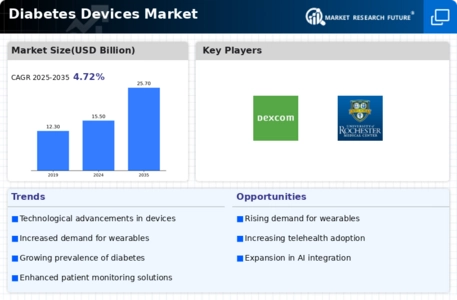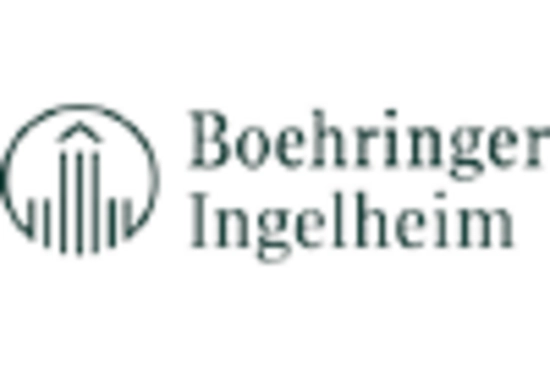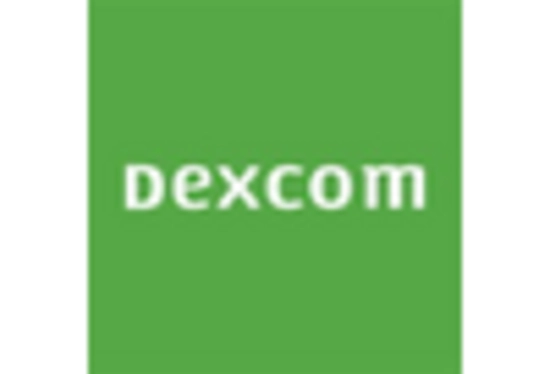Blood Glucose Monitors
Insulin Delivery Devices
Continuous Glucose Monitoring Systems
Diabetes Management Software
Hospitals
Homecare
Diabetes Clinics
Ambulatory Surgical Centers
Online Pharmacies
Retail Pharmacies
Hospital Pharmacies
Direct Sales
Type 1 Diabetes
Type 2 Diabetes
Gestational Diabetes
North America
Europe
South America
Asia Pacific
Middle East and Africa
North America Outlook (USD Billion, 2019-2035)
North America Diabetes Devices Market by Device Type
Blood Glucose Monitors
Insulin Delivery Devices
Continuous Glucose Monitoring Systems
Diabetes Management Software
North America Diabetes Devices Market by End User Type
Hospitals
Homecare
Diabetes Clinics
Ambulatory Surgical Centers
North America Diabetes Devices Market by Distribution Channel Type
Online Pharmacies
Retail Pharmacies
Hospital Pharmacies
Direct Sales
North America Diabetes Devices Market by Application Type
Type 1 Diabetes
Type 2 Diabetes
Gestational Diabetes
North America Diabetes Devices Market by Regional Type
US
Canada
US Outlook (USD Billion, 2019-2035)
US Diabetes Devices Market by Device Type
Blood Glucose Monitors
Insulin Delivery Devices
Continuous Glucose Monitoring Systems
Diabetes Management Software
US Diabetes Devices Market by End User Type
Hospitals
Homecare
Diabetes Clinics
Ambulatory Surgical Centers
US Diabetes Devices Market by Distribution Channel Type
Online Pharmacies
Retail Pharmacies
Hospital Pharmacies
Direct Sales
US Diabetes Devices Market by Application Type
Type 1 Diabetes
Type 2 Diabetes
Gestational Diabetes
CANADA Outlook (USD Billion, 2019-2035)
CANADA Diabetes Devices Market by Device Type
Blood Glucose Monitors
Insulin Delivery Devices
Continuous Glucose Monitoring Systems
Diabetes Management Software
CANADA Diabetes Devices Market by End User Type
Hospitals
Homecare
Diabetes Clinics
Ambulatory Surgical Centers
CANADA Diabetes Devices Market by Distribution Channel Type
Online Pharmacies
Retail Pharmacies
Hospital Pharmacies
Direct Sales
CANADA Diabetes Devices Market by Application Type
Type 1 Diabetes
Type 2 Diabetes
Gestational Diabetes
Europe Outlook (USD Billion, 2019-2035)
Europe Diabetes Devices Market by Device Type
Blood Glucose Monitors
Insulin Delivery Devices
Continuous Glucose Monitoring Systems
Diabetes Management Software
Europe Diabetes Devices Market by End User Type
Hospitals
Homecare
Diabetes Clinics
Ambulatory Surgical Centers
Europe Diabetes Devices Market by Distribution Channel Type
Online Pharmacies
Retail Pharmacies
Hospital Pharmacies
Direct Sales
Europe Diabetes Devices Market by Application Type
Type 1 Diabetes
Type 2 Diabetes
Gestational Diabetes
Europe Diabetes Devices Market by Regional Type
Germany
UK
France
Russia
Italy
Spain
Rest of Europe
GERMANY Outlook (USD Billion, 2019-2035)
GERMANY Diabetes Devices Market by Device Type
Blood Glucose Monitors
Insulin Delivery Devices
Continuous Glucose Monitoring Systems
Diabetes Management Software
GERMANY Diabetes Devices Market by End User Type
Hospitals
Homecare
Diabetes Clinics
Ambulatory Surgical Centers
GERMANY Diabetes Devices Market by Distribution Channel Type
Online Pharmacies
Retail Pharmacies
Hospital Pharmacies
Direct Sales
GERMANY Diabetes Devices Market by Application Type
Type 1 Diabetes
Type 2 Diabetes
Gestational Diabetes
UK Outlook (USD Billion, 2019-2035)
UK Diabetes Devices Market by Device Type
Blood Glucose Monitors
Insulin Delivery Devices
Continuous Glucose Monitoring Systems
Diabetes Management Software
UK Diabetes Devices Market by End User Type
Hospitals
Homecare
Diabetes Clinics
Ambulatory Surgical Centers
UK Diabetes Devices Market by Distribution Channel Type
Online Pharmacies
Retail Pharmacies
Hospital Pharmacies
Direct Sales
UK Diabetes Devices Market by Application Type
Type 1 Diabetes
Type 2 Diabetes
Gestational Diabetes
FRANCE Outlook (USD Billion, 2019-2035)
FRANCE Diabetes Devices Market by Device Type
Blood Glucose Monitors
Insulin Delivery Devices
Continuous Glucose Monitoring Systems
Diabetes Management Software
FRANCE Diabetes Devices Market by End User Type
Hospitals
Homecare
Diabetes Clinics
Ambulatory Surgical Centers
FRANCE Diabetes Devices Market by Distribution Channel Type
Online Pharmacies
Retail Pharmacies
Hospital Pharmacies
Direct Sales
FRANCE Diabetes Devices Market by Application Type
Type 1 Diabetes
Type 2 Diabetes
Gestational Diabetes
RUSSIA Outlook (USD Billion, 2019-2035)
RUSSIA Diabetes Devices Market by Device Type
Blood Glucose Monitors
Insulin Delivery Devices
Continuous Glucose Monitoring Systems
Diabetes Management Software
RUSSIA Diabetes Devices Market by End User Type
Hospitals
Homecare
Diabetes Clinics
Ambulatory Surgical Centers
RUSSIA Diabetes Devices Market by Distribution Channel Type
Online Pharmacies
Retail Pharmacies
Hospital Pharmacies
Direct Sales
RUSSIA Diabetes Devices Market by Application Type
Type 1 Diabetes
Type 2 Diabetes
Gestational Diabetes
ITALY Outlook (USD Billion, 2019-2035)
ITALY Diabetes Devices Market by Device Type
Blood Glucose Monitors
Insulin Delivery Devices
Continuous Glucose Monitoring Systems
Diabetes Management Software
ITALY Diabetes Devices Market by End User Type
Hospitals
Homecare
Diabetes Clinics
Ambulatory Surgical Centers
ITALY Diabetes Devices Market by Distribution Channel Type
Online Pharmacies
Retail Pharmacies
Hospital Pharmacies
Direct Sales
ITALY Diabetes Devices Market by Application Type
Type 1 Diabetes
Type 2 Diabetes
Gestational Diabetes
SPAIN Outlook (USD Billion, 2019-2035)
SPAIN Diabetes Devices Market by Device Type
Blood Glucose Monitors
Insulin Delivery Devices
Continuous Glucose Monitoring Systems
Diabetes Management Software
SPAIN Diabetes Devices Market by End User Type
Hospitals
Homecare
Diabetes Clinics
Ambulatory Surgical Centers
SPAIN Diabetes Devices Market by Distribution Channel Type
Online Pharmacies
Retail Pharmacies
Hospital Pharmacies
Direct Sales
SPAIN Diabetes Devices Market by Application Type
Type 1 Diabetes
Type 2 Diabetes
Gestational Diabetes
REST OF EUROPE Outlook (USD Billion, 2019-2035)
REST OF EUROPE Diabetes Devices Market by Device Type
Blood Glucose Monitors
Insulin Delivery Devices
Continuous Glucose Monitoring Systems
Diabetes Management Software
REST OF EUROPE Diabetes Devices Market by End User Type
Hospitals
Homecare
Diabetes Clinics
Ambulatory Surgical Centers
REST OF EUROPE Diabetes Devices Market by Distribution Channel Type
Online Pharmacies
Retail Pharmacies
Hospital Pharmacies
Direct Sales
REST OF EUROPE Diabetes Devices Market by Application Type
Type 1 Diabetes
Type 2 Diabetes
Gestational Diabetes
APAC Outlook (USD Billion, 2019-2035)
APAC Diabetes Devices Market by Device Type
Blood Glucose Monitors
Insulin Delivery Devices
Continuous Glucose Monitoring Systems
Diabetes Management Software
APAC Diabetes Devices Market by End User Type
Hospitals
Homecare
Diabetes Clinics
Ambulatory Surgical Centers
APAC Diabetes Devices Market by Distribution Channel Type
Online Pharmacies
Retail Pharmacies
Hospital Pharmacies
Direct Sales
APAC Diabetes Devices Market by Application Type
Type 1 Diabetes
Type 2 Diabetes
Gestational Diabetes
APAC Diabetes Devices Market by Regional Type
China
India
Japan
South Korea
Malaysia
Thailand
Indonesia
Rest of APAC
CHINA Outlook (USD Billion, 2019-2035)
CHINA Diabetes Devices Market by Device Type
Blood Glucose Monitors
Insulin Delivery Devices
Continuous Glucose Monitoring Systems
Diabetes Management Software
CHINA Diabetes Devices Market by End User Type
Hospitals
Homecare
Diabetes Clinics
Ambulatory Surgical Centers
CHINA Diabetes Devices Market by Distribution Channel Type
Online Pharmacies
Retail Pharmacies
Hospital Pharmacies
Direct Sales
CHINA Diabetes Devices Market by Application Type
Type 1 Diabetes
Type 2 Diabetes
Gestational Diabetes
INDIA Outlook (USD Billion, 2019-2035)
INDIA Diabetes Devices Market by Device Type
Blood Glucose Monitors
Insulin Delivery Devices
Continuous Glucose Monitoring Systems
Diabetes Management Software
INDIA Diabetes Devices Market by End User Type
Hospitals
Homecare
Diabetes Clinics
Ambulatory Surgical Centers
INDIA Diabetes Devices Market by Distribution Channel Type
Online Pharmacies
Retail Pharmacies
Hospital Pharmacies
Direct Sales
INDIA Diabetes Devices Market by Application Type
Type 1 Diabetes
Type 2 Diabetes
Gestational Diabetes
JAPAN Outlook (USD Billion, 2019-2035)
JAPAN Diabetes Devices Market by Device Type
Blood Glucose Monitors
Insulin Delivery Devices
Continuous Glucose Monitoring Systems
Diabetes Management Software
JAPAN Diabetes Devices Market by End User Type
Hospitals
Homecare
Diabetes Clinics
Ambulatory Surgical Centers
JAPAN Diabetes Devices Market by Distribution Channel Type
Online Pharmacies
Retail Pharmacies
Hospital Pharmacies
Direct Sales
JAPAN Diabetes Devices Market by Application Type
Type 1 Diabetes
Type 2 Diabetes
Gestational Diabetes
SOUTH KOREA Outlook (USD Billion, 2019-2035)
SOUTH KOREA Diabetes Devices Market by Device Type
Blood Glucose Monitors
Insulin Delivery Devices
Continuous Glucose Monitoring Systems
Diabetes Management Software
SOUTH KOREA Diabetes Devices Market by End User Type
Hospitals
Homecare
Diabetes Clinics
Ambulatory Surgical Centers
SOUTH KOREA Diabetes Devices Market by Distribution Channel Type
Online Pharmacies
Retail Pharmacies
Hospital Pharmacies
Direct Sales
SOUTH KOREA Diabetes Devices Market by Application Type
Type 1 Diabetes
Type 2 Diabetes
Gestational Diabetes
MALAYSIA Outlook (USD Billion, 2019-2035)
MALAYSIA Diabetes Devices Market by Device Type
Blood Glucose Monitors
Insulin Delivery Devices
Continuous Glucose Monitoring Systems
Diabetes Management Software
MALAYSIA Diabetes Devices Market by End User Type
Hospitals
Homecare
Diabetes Clinics
Ambulatory Surgical Centers
MALAYSIA Diabetes Devices Market by Distribution Channel Type
Online Pharmacies
Retail Pharmacies
Hospital Pharmacies
Direct Sales
MALAYSIA Diabetes Devices Market by Application Type
Type 1 Diabetes
Type 2 Diabetes
Gestational Diabetes
THAILAND Outlook (USD Billion, 2019-2035)
THAILAND Diabetes Devices Market by Device Type
Blood Glucose Monitors
Insulin Delivery Devices
Continuous Glucose Monitoring Systems
Diabetes Management Software
THAILAND Diabetes Devices Market by End User Type
Hospitals
Homecare
Diabetes Clinics
Ambulatory Surgical Centers
THAILAND Diabetes Devices Market by Distribution Channel Type
Online Pharmacies
Retail Pharmacies
Hospital Pharmacies
Direct Sales
THAILAND Diabetes Devices Market by Application Type
Type 1 Diabetes
Type 2 Diabetes
Gestational Diabetes
INDONESIA Outlook (USD Billion, 2019-2035)
INDONESIA Diabetes Devices Market by Device Type
Blood Glucose Monitors
Insulin Delivery Devices
Continuous Glucose Monitoring Systems
Diabetes Management Software
INDONESIA Diabetes Devices Market by End User Type
Hospitals
Homecare
Diabetes Clinics
Ambulatory Surgical Centers
INDONESIA Diabetes Devices Market by Distribution Channel Type
Online Pharmacies
Retail Pharmacies
Hospital Pharmacies
Direct Sales
INDONESIA Diabetes Devices Market by Application Type
Type 1 Diabetes
Type 2 Diabetes
Gestational Diabetes
REST OF APAC Outlook (USD Billion, 2019-2035)
REST OF APAC Diabetes Devices Market by Device Type
Blood Glucose Monitors
Insulin Delivery Devices
Continuous Glucose Monitoring Systems
Diabetes Management Software
REST OF APAC Diabetes Devices Market by End User Type
Hospitals
Homecare
Diabetes Clinics
Ambulatory Surgical Centers
REST OF APAC Diabetes Devices Market by Distribution Channel Type
Online Pharmacies
Retail Pharmacies
Hospital Pharmacies
Direct Sales
REST OF APAC Diabetes Devices Market by Application Type
Type 1 Diabetes
Type 2 Diabetes
Gestational Diabetes
South America Outlook (USD Billion, 2019-2035)
South America Diabetes Devices Market by Device Type
Blood Glucose Monitors
Insulin Delivery Devices
Continuous Glucose Monitoring Systems
Diabetes Management Software
South America Diabetes Devices Market by End User Type
Hospitals
Homecare
Diabetes Clinics
Ambulatory Surgical Centers
South America Diabetes Devices Market by Distribution Channel Type
Online Pharmacies
Retail Pharmacies
Hospital Pharmacies
Direct Sales
South America Diabetes Devices Market by Application Type
Type 1 Diabetes
Type 2 Diabetes
Gestational Diabetes
South America Diabetes Devices Market by Regional Type
Brazil
Mexico
Argentina
Rest of South America
BRAZIL Outlook (USD Billion, 2019-2035)
BRAZIL Diabetes Devices Market by Device Type
Blood Glucose Monitors
Insulin Delivery Devices
Continuous Glucose Monitoring Systems
Diabetes Management Software
BRAZIL Diabetes Devices Market by End User Type
Hospitals
Homecare
Diabetes Clinics
Ambulatory Surgical Centers
BRAZIL Diabetes Devices Market by Distribution Channel Type
Online Pharmacies
Retail Pharmacies
Hospital Pharmacies
Direct Sales
BRAZIL Diabetes Devices Market by Application Type
Type 1 Diabetes
Type 2 Diabetes
Gestational Diabetes
MEXICO Outlook (USD Billion, 2019-2035)
MEXICO Diabetes Devices Market by Device Type
Blood Glucose Monitors
Insulin Delivery Devices
Continuous Glucose Monitoring Systems
Diabetes Management Software
MEXICO Diabetes Devices Market by End User Type
Hospitals
Homecare
Diabetes Clinics
Ambulatory Surgical Centers
MEXICO Diabetes Devices Market by Distribution Channel Type
Online Pharmacies
Retail Pharmacies
Hospital Pharmacies
Direct Sales
MEXICO Diabetes Devices Market by Application Type
Type 1 Diabetes
Type 2 Diabetes
Gestational Diabetes
ARGENTINA Outlook (USD Billion, 2019-2035)
ARGENTINA Diabetes Devices Market by Device Type
Blood Glucose Monitors
Insulin Delivery Devices
Continuous Glucose Monitoring Systems
Diabetes Management Software
ARGENTINA Diabetes Devices Market by End User Type
Hospitals
Homecare
Diabetes Clinics
Ambulatory Surgical Centers
ARGENTINA Diabetes Devices Market by Distribution Channel Type
Online Pharmacies
Retail Pharmacies
Hospital Pharmacies
Direct Sales
ARGENTINA Diabetes Devices Market by Application Type
Type 1 Diabetes
Type 2 Diabetes
Gestational Diabetes
REST OF SOUTH AMERICA Outlook (USD Billion, 2019-2035)
REST OF SOUTH AMERICA Diabetes Devices Market by Device Type
Blood Glucose Monitors
Insulin Delivery Devices
Continuous Glucose Monitoring Systems
Diabetes Management Software
REST OF SOUTH AMERICA Diabetes Devices Market by End User Type
Hospitals
Homecare
Diabetes Clinics
Ambulatory Surgical Centers
REST OF SOUTH AMERICA Diabetes Devices Market by Distribution Channel Type
Online Pharmacies
Retail Pharmacies
Hospital Pharmacies
Direct Sales
REST OF SOUTH AMERICA Diabetes Devices Market by Application Type
Type 1 Diabetes
Type 2 Diabetes
Gestational Diabetes
MEA Outlook (USD Billion, 2019-2035)
MEA Diabetes Devices Market by Device Type
Blood Glucose Monitors
Insulin Delivery Devices
Continuous Glucose Monitoring Systems
Diabetes Management Software
MEA Diabetes Devices Market by End User Type
Hospitals
Homecare
Diabetes Clinics
Ambulatory Surgical Centers
MEA Diabetes Devices Market by Distribution Channel Type
Online Pharmacies
Retail Pharmacies
Hospital Pharmacies
Direct Sales
MEA Diabetes Devices Market by Application Type
Type 1 Diabetes
Type 2 Diabetes
Gestational Diabetes
MEA Diabetes Devices Market by Regional Type
GCC Countries
South Africa
Rest of MEA
GCC COUNTRIES Outlook (USD Billion, 2019-2035)
GCC COUNTRIES Diabetes Devices Market by Device Type
Blood Glucose Monitors
Insulin Delivery Devices
Continuous Glucose Monitoring Systems
Diabetes Management Software
GCC COUNTRIES Diabetes Devices Market by End User Type
Hospitals
Homecare
Diabetes Clinics
Ambulatory Surgical Centers
GCC COUNTRIES Diabetes Devices Market by Distribution Channel Type
Online Pharmacies
Retail Pharmacies
Hospital Pharmacies
Direct Sales
GCC COUNTRIES Diabetes Devices Market by Application Type
Type 1 Diabetes
Type 2 Diabetes
Gestational Diabetes
SOUTH AFRICA Outlook (USD Billion, 2019-2035)
SOUTH AFRICA Diabetes Devices Market by Device Type
Blood Glucose Monitors
Insulin Delivery Devices
Continuous Glucose Monitoring Systems
Diabetes Management Software
SOUTH AFRICA Diabetes Devices Market by End User Type
Hospitals
Homecare
Diabetes Clinics
Ambulatory Surgical Centers
SOUTH AFRICA Diabetes Devices Market by Distribution Channel Type
Online Pharmacies
Retail Pharmacies
Hospital Pharmacies
Direct Sales
SOUTH AFRICA Diabetes Devices Market by Application Type
Type 1 Diabetes
Type 2 Diabetes
Gestational Diabetes
REST OF MEA Outlook (USD Billion, 2019-2035)
REST OF MEA Diabetes Devices Market by Device Type
Blood Glucose Monitors
Insulin Delivery Devices
Continuous Glucose Monitoring Systems
Diabetes Management Software
REST OF MEA Diabetes Devices Market by End User Type
Hospitals
Homecare
Diabetes Clinics
Ambulatory Surgical Centers
REST OF MEA Diabetes Devices Market by Distribution Channel Type
Online Pharmacies
Retail Pharmacies
Hospital Pharmacies
Direct Sales
REST OF MEA Diabetes Devices Market by Application Type
Type 1 Diabetes
Type 2 Diabetes
Gestational Diabetes










Leave a Comment